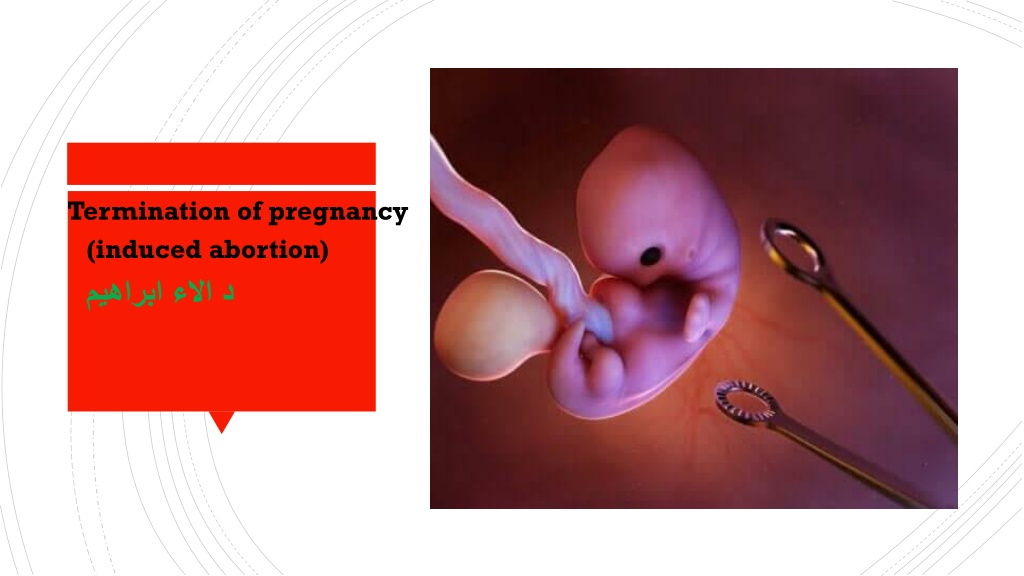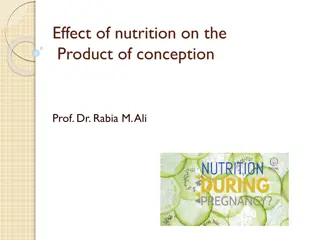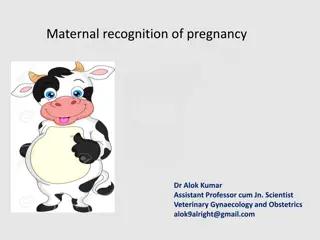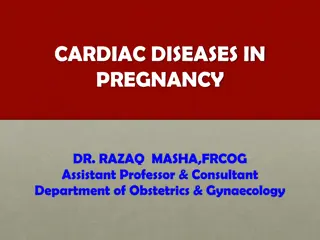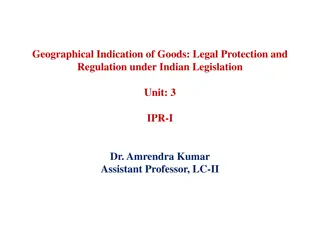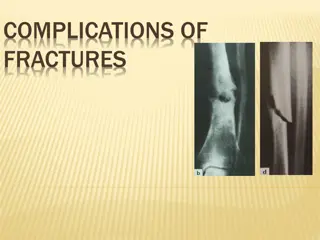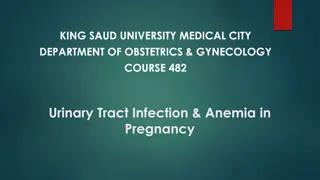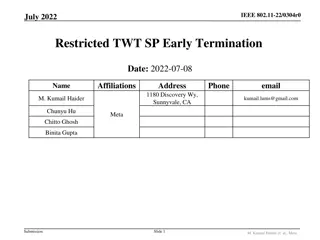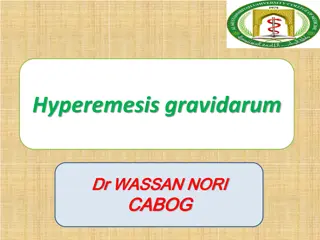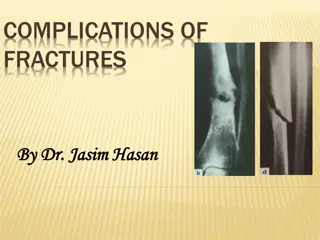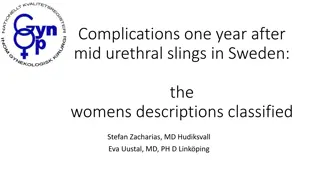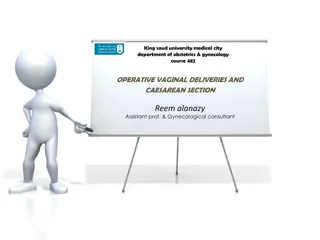Understanding Termination of Pregnancy: Indications, Methods, and Complications
Induced abortion, whether medical or surgical, is defined as the deliberate termination of pregnancy before fetal viability. This article highlights the various indications for termination, such as risks to the mother's health or fetal abnormalities, and the methods used for termination in different trimesters. It also discusses the legal aspects, including the need for written consent from the woman and the permissible timeframe for termination.
- Pregnancy termination
- Abortion methods
- Indications for abortion
- Fetal abnormalities
- Legal considerations
Download Presentation

Please find below an Image/Link to download the presentation.
The content on the website is provided AS IS for your information and personal use only. It may not be sold, licensed, or shared on other websites without obtaining consent from the author. Download presentation by click this link. If you encounter any issues during the download, it is possible that the publisher has removed the file from their server.
E N D
Presentation Transcript
Termination of pregnancy (induced abortion)
1. To know the indication for termination of pregnancy. Objective: Objective: 2.To know the methods of terminations. 3.The complications of termination
Induction of abortion is defined as deliberate termination of pregnancy either by medical or by surgical method before the viability of the fetus. INDUCTION OF INDUCTION OF ABORTION: ABORTION: The induced abortion may be legal or illegal (criminal).
The indications: The continuation of pregnancy would involve serious risk of life or grave injury to the physical and mental health of the pregnant woman. There is a substantial risk of the child being born with serious physical and mental abnormalities so as to be handicapped in life; i. Structural (Anencephaly), chromosomal(Down s syndrome) or genetic (Hemophilia) abnormalities of the fetus. MEDICAL MEDICAL TERMINATION OF TERMINATION OF PREGNANCY PREGNANCY (MTP) (MTP) ii. When the fetus is likely to be deformed due to action of teratogenic drugs (warfarin) or radiation exposure (>10 rad) in early pregnancy. iii. Rubella, a viral infection affecting in the "first trimester. When the pregnancy is caused by rape. To save the life of the mother (therapeutic or Medical termination): (i) Cardiac diseases (Grade III and IV) with history of decompensation in the previous pregnancy or in between the pregnancies. (ii) Chronic glomerulonephritis. (iii) Malignant hypertension. (iv) Intractable hyperemesis gravidarum. (v) Cervical or breast malignancy. (vi) Diabetes mellitus with retinopathy. (vii) Epilepsy or psychiatric illness. Social indications.
Termination can only be performed in hospitals, established or maintained by the government or places approved by the government. Pregnancy can only be terminated on the written consent of the woman. Husband s consent is not required. RECOMMENDATIONS RECOMMENDATIONS Pregnancy in a minor girl (below the age of 18 years) cannot be terminated without written consent of the parents or legal guardian. Termination is permitted up to 20 weeks of pregnancy. When the pregnancy exceeds 12 weeks, opinion of two medical practitioners is required.
Medical Surgical First Trimester (Up to 12 Weeks) METHODS OF METHODS OF TERMINATION OF TERMINATION OF PREGNANCY: PREGNANCY: Second Trimester (13 20 Weeks)
MEDICAL METHODS OF FIRST TRIMESTER ABORTION. FIRST TRIMESTER FIRST TRIMESTER TERMINATION OF TERMINATION OF PREGNANCY PREGNANCY SURGICAL METHODS OF FIRST TRIMESTER ABORTION.
Mifepristone (RU-486) and Misoprostol: Mefipristone is a synthetic steroid that block biological action of progesterone by binding to its receptor in the uterus ,following withdrwal of the effect of progesterone, the uterus contracts and bleeding from placental bed, followed by abortion 2-5 days later PROTOCOL: A 200 mg of mifepristone orally is given on day 1. On day 3, misoprostol (PGE1) 400 mcg orally or 800 mcg vaginally is given. Patient remains in the clinic for 4 hours during which expulsion of the conceptus (95%) often occurs. MEDICAL METHODS MEDICAL METHODS OF FIRST TRIMESTER OF FIRST TRIMESTER ABORTION: ABORTION: Patient is reexamined after 10 14 days. Complete abortion is observed in 95%, incomplete in about 2% of cases and about 1% do not respond at all. Oral mifepristone 200 mg (1 tab) with vaginal misoprostol 800 mcg (4 tab, 200 mcg each) after 6 48 hours is equally effective. Medical methods are safe, effective, noninvasive and have minimal or no complications. Methotrexate and Misoprostol Methotrexate 50 mg/m2 IM (before 56 days of gestation) followed by 7 days later misoprostol 800 mcg vaginally is highly effective. Misoprostol may have to be repeated after 24 hours if it fails. If the procedure fails, ultrasound examination is done to confirm the failure. Then suction evacuation should be done. Methotrexate and misoprostol regimen is less expensive but takes longer time than mifepristone and misoprostol.
VACUUM ASPIRATION (MVA/EVA): is done up to 12 weeks with minimal cervical dilatation. SURGICAL METHODS SURGICAL METHODS OF FIRST TRIMESTER OF FIRST TRIMESTER ABORTION: ABORTION: It is performed as an outpatient procedure using a plastic disposable cannula (up to 12 mm size) and a 60 mL plastic (double valve) syringe. It is quicker (15 minutes), effective (98 100%), less traumatic and safer than dilatation, evacuation and curettage .
SUCTION EVACUATION AND/OR CURETTAGE: This consists of a suction machine fitted with a cannula either plastic (Karman) or metal available in various sizes. Advantages: (1) It is done as an outdoor procedure. (2) Hazards of general anesthesia are absent as it is done, at best, under paracervical block anesthesia. (3) Ideal for termination for therapeutic indications. (4) Blood loss is minimal. (5) Chance of uterine perforation is much less especially with the plastic cannula. Drawbacks: (1) The method is not suitable with bigger size uterus of more than 10 weeks as chance of retained products is more. (2) Requires electricity to operate and the machine is costly.
DILATATION AND EVACUATION.
MEDICAL METHODS: PROSTAGLANDINS: Prostaglandins and their analogs are very much effective. They are used extensively, especially in the second trimester. They act on the cervix and the uterus. The PGE (dinoprostone, sulprostone, gemeprost, misoprostol) and PGF (carboprost) analogs are commonly MIDTRIMESTER MIDTRIMESTER TERMINATION OF TERMINATION OF PREGNANCY PREGNANCY used. PGEs are preferred as they have more selective action on the myometrium and less side effects. (i) Misoprostol (PGE1 analog): 400 800 mcg of misoprostol given vaginally at an interval of 3 4 hours is most effective as the bioavailability is high. This regimen has got 100% success in second trimester abortion. The mean induction abortion interval is 11 12 hours. (ii) Mifepristone and prostaglandins: Mifepristone 200 mg oral, followed 36 48 hours later by misoprostol 800 mcg vaginal; then misoprostol 400 mcg oral every 3 hours for four doses is used. Success rate of abortion is 97% and median induction delivery interval is 6.5 hours. (iii) Gemeprost (PGE1 analog): 1 mg vaginal pessary every 3 6 hours for five doses in 24 hours has got about 90% success. (iv) Dinoprostone (PGE2 analog): 20 mg is used as a vaginal suppository every 3 4 hours (maximum for 4 6 doses). PGE2 is thermolabile (needs refrigeration) and is expensive. (v) Prostaglandin F2D (PGF2D), carboprost tromethamine 250 mcg IM every 3 hours for a maximum ten doses can be used.
OXYTOCIN: High-dose oxytocin as a single agent can be used for second trimester abortion. It is effective in 80% of cases. It can be used with intravenous normal saline along with any of the medications used either intra-amniotic or extra-amniotic space in an attempt to augment the abortion process. Currently high dose (up to 300 units in 500 mL of dextrose saline) is favored.
It is difficult to terminate pregnancy in the second trimester with reasonable safety as in first trimester. The following surgical methods may be employed. Between 13 weeks and 15 weeks Dilatation and Evacuation in the mid trimester is less commonly done. Pregnancies at 13 14 menstrual weeks are evacuated. SURGICAL METHODS: SURGICAL METHODS: In all midtrimester abortion, cervical preparation must be used to make the process easy and safe: - Intracervical tent (Laminaria osmotic dilator). -mifepristone or misoprostol are used as the cervical priming agents. the procedure may need to be performed under ultrasound guidance to reduce the risk of complications. Simultaneous use of oxytocin infusion is useful.
Between 16 weeks and 20 weeks: INTRAUTERINE INSTILLATION OF HYPERTONIC SOLUTION: Isotonic saline is infused extra-amniotically using a transcervical catheter balloon. Results are similar to that of Foley s catheter use alone. Intra-amniotic: Intra-amniotic instillation of hypertonic saline (20%) is less commonly used now. It is instilled through the abdominal route. HYSTEROTOMY:The operation is performed through abdominal route. Indications: (i) Prior failed medical termination of pregnancy (TOP) (ii) Cases where D&E cannot be safely done: (a) fibroid in the lower uterine segment, (b) uterine anomalies, (c) patients with repeated scarred uterus with placenta accreta or percreta. It is less commonly done these days.
IMMEDIATE: (1) Injury to the cervix (cervical lacerations). (2) Uterine perforation during D&E. (3) Hemorrhage and shock due to trauma, incomplete abortion, atonic uterus or rarely coagulation failure. (4) Thrombosis or embolism. COMPLICATION COMPLICATION S OF MTP S OF MTP (5) Postabortal triad of pain, bleeding and low-grade fever due to retained clots or products. Antibiotics should be continued, may need repeat evacuation. (6) Related to the methods employed: Prostaglandins intractable vomiting, diarrhea, fever, uterine pain and cervicouterine injury. Oxytocin water intoxication and rarely convulsions z Hysterotomy. Saline hypernatremia, pulmonary edema.
REMOTE:The complications are grouped into: 1.Gynecological complications include (a) menstrual disturbances, (b) chronic pelvic infammation, (c) infertility due to cornual block, (d) scar endometriosis and (e) uterine synechiae leading to secondary amenorrhea. 2.Obstetrical complications include: (a) recurrent midtrimester abortion due to cervical incompetence, (b) ectopic pregnancy, (c) preterm labor, (e) increased perinatal loss, (f) rupture uterus, (g) Rh-isoimmunization in Rh-negative women, if not prophylactically protected with immunoglobulin and (h) failed abortion and continued pregnancy. MORTALITY: First trimester: The maternal death is lowest especially with MVA and suction evacuation. Midtrimester: The mortality rate increases five to six times to that of first trimester.
